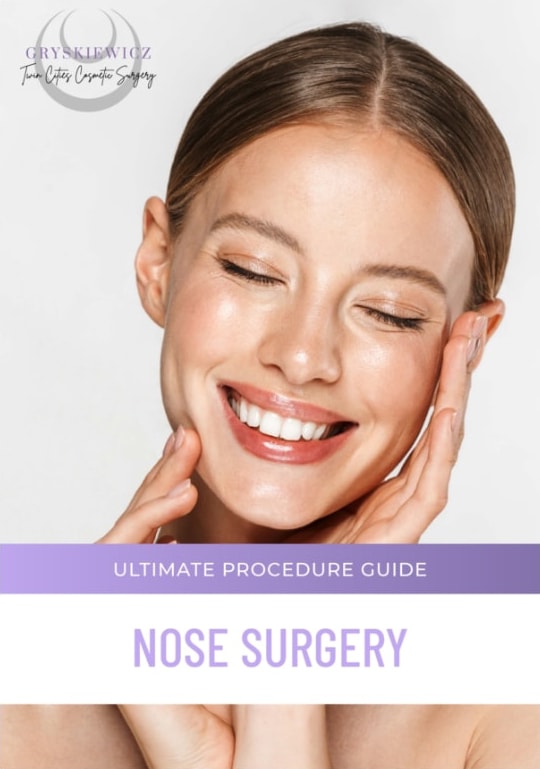Ethnic Rhinoplasty
March 13, 2023
 Written By Joe Gryskiewicz, MD, FACS
Written By Joe Gryskiewicz, MD, FACS
The nose is central to the face. Therefore, it is easily noticeable. In addition, the size and shape of your nose significantly affects your appearance. Therefore, a nose that lacks definition and proportion not only affects your beauty, it can also affect your self-esteem. Fortunately, with a rhinoplasty, you can correct your nose’s appearance to look better.
However, even if you want to get a rhinoplasty to improve your nose’s appearance, it is essential to note that every ethnicity requires specific work. For instance, a caucasian’s nose has significantly different features from an African-American’s nose.
Because of these unique differences, it is essential to get ethnic rhinoplasty from an expert plastic surgeon. Dr. Joe is a plastic surgeon with a lot of experience in ethnic rhinoplasty, with hundreds of successful nose jobs and satisfied patients.
What Is Ethnic Rhinoplasty?
Ethnic rhinoplasty is a nose job for people of other ethnicities beyond Caucasians. This nose job improves your nose’s size and shape to suit your race. As a person of another descent, getting Caucasian rhinoplasty may result in multiple revisional surgeries and breathing difficulties.
Dr. Joe considers the features of your nose based on your ethnicity and prescribes treatment that improves your nose while preserving the features of your race.
How Is Ethnic Rhinoplasty Different From Rhinoplasty?
Ethnic rhinoplasty is quite similar to a traditional nose job because both procedures involve manipulating the nose’s bone and tissues to improve its appearance and function.
The most significant difference between the two procedures is that Dr. Joe focuses on the structural features of an ethnic nose during an ethnic nose job. Consequently, you get a natural-looking nose that preserves your ethnicity.
Ethnic Rhinoplasty Procedures
 There are different nose job procedures that Dr. Joe uses to improve your nose’s appearance. These procedures can be stand-alone or used in combination with each other for the best results. Ethnic rhinoplasty procedures include:
There are different nose job procedures that Dr. Joe uses to improve your nose’s appearance. These procedures can be stand-alone or used in combination with each other for the best results. Ethnic rhinoplasty procedures include:
- Cartilage reduction: Dr. Joe reduces the physical size of the nose by removing bone and cartilage in the underlying structures. Cartilage reduction brings previously protruding nasal features closer to your face. This nose job is prevalent in Middle Eastern rhinoplasty;
- Cartilage projection: grafting cartilage to a patient’s nose enlarges its physical size, increasing projection. Dr. Joe harvests cartilage from the septum, rib, or ear and adds it to the nose’s flat areas. Thus, the nose sticks out farther from the face and has a narrower and more balanced look. Cartilage projection is especially common in Asian, African-American, and Hispanic patients;
- Cartilage augmentation: nose augmentation or rearrangement is particular to all ethnicities. In cartilage augmentation, there is no addition or removal of nose cartilage. Instead, Dr. Joe makes subtle changes to specific nose angles to improve definition and balance.
With cartilage rearrangement, your surgeon can create a more defined line around where your nostrils meet the nose bridge to create a narrower nose tip. In addition, pointing the nose tip up or down allows your surgeon to change how your nose appears to stick from your face.
How Do You Get Ethnic Rhinoplasty?
Ethnic rhinoplasty changes the appearance of your nose, giving you a well-balanced and aesthetically pleasing look. However, before you can get the procedure, you must consult Dr. Joe. During the consultation, your surgeon will review your medical history and the aspects of your nose.
If you qualify for the procedure, Dr. Joe will develop a customized treatment plan that suits your goals. However, it is essential to note that you must have realistic expectations to qualify for an ethnic rhinoplasty. Furthermore, your surgeon will give you instructions pre and post-operation for a smooth surgery and fast recovery.
During the ethnic nose job procedure, you will receive general anesthesia, which numbs you to pain. Afterwards, Dr. Joe will make incisions on the inside or rarely the outside of your nose, depending on what needs to be corrected. Dr. Joe specializes in “Scarless Rhinoplasty” or “Incisionless Rhinoplasty” where only internal incisions are made.
Next, your surgeon will separate the nasal skin layer from the bone and cartilage. Then, depending on your needs, your surgeon will carry out cartilage augmentation, reduction, or projection. The procedure is outpatient, and you should be able to go home the same day after your surgery.
The results of an ethnic rhinoplasty are visible immediately after the procedure. However, you may not see it clearly due to swelling. Fortunately, the swelling should reduce in a few days. Remember, this is a one year journey until all the swelling is gone. There are subtle changes up to a year.
What Are The Different Types of Ethnic Rhinoplasty?
 Each ethnic group has diverse physical traits that distinguish them. There is a specific rhinoplasty that suits each group
Each ethnic group has diverse physical traits that distinguish them. There is a specific rhinoplasty that suits each group
-
African-American Rhinoplasty
African-Americans have characteristic noses with thick skin and weak internal structures, resulting in a less defined and under-projected nose tip. The noses of this ethnic group may also have a flat and wide bridge.
African-American rhinoplasty improves the noses of African-American patients while preserving their ethnicity. This type of rhinoplasty involves cartilage augmentation and projection to narrow and increase the height of the nasal bridge. In addition, an African-American nose job enhances the definition and projection of the nose, creating a balanced shape.
Because of the particularities of this ethnic group’s nose, there is a risk of the nose bridge becoming narrower than the nostrils. This deviates from the racial harmony of the nose. Fortunately, Dr. Joe specializes in African-American rhinoplasty with multiple satisfying results. Please go to his website to view photos.
-
Middle Eastern Rhinoplasty
Middle easterners have over-projected noses with thick skin. Because their noses have bulbous tips, breathing can be pretty difficult. Furthermore, people of middle eastern descent often have noses with deviated septums. Other characteristics of a Middle Eastern nose are the dorsal bump or hump, an undefined nasal tip, and an underdeveloped nose radix.
Middle eastern rhinoplasty straightens the nose and refines the nose tip. Dr. Joe uses this rhinoplasty to remove the dorsal hump and raise the nose’s radix. In addition, your surgeon can use cartilage augmentation and reduction techniques to improve the nasal proportions without collapsing the nose.
-
Hispanic/Latinos Rhinoplasty
Hispanics and Latinos have a range of nasal features depending on their archetypes. Some archetypes have high radix and a prominent nose vault. While some have noses with dependent tips and poor projection, others have noses with broad nasal bases, thick skin, and wide tips. Generally, Hispanics and Latinos share nasal characteristics, including a bulbous nose tip and thick skin.
Depending on the archetypes, Dr. Joe can carry out cartilage reduction, augmentation, or projection to improve the nose’s appearance. For example, Hispanic nose jobs can reduce the nasal hump and width of the nose’s base.
 Asians have a flat nasal profile and slight nasal bridge. Their nose tips are usually broad and weak, and they have flared nostrils. In addition, Asian noses have thick skin.
Asians have a flat nasal profile and slight nasal bridge. Their nose tips are usually broad and weak, and they have flared nostrils. In addition, Asian noses have thick skin.
An Asian rhinoplasty may involve augmentation and projection techniques to improve the nose profile and create a more balanced look.
Why Should You Get Ethnic Rhinoplasty?
Ethnic rhinoplasty has several benefits, including improving the appearance of your nose. Other benefits of the procedure include correcting breathing difficulties and improving your nose projection. In addition, if you have a small nose, an ethnic nose job can enhance its definition.
Another benefit of ethnic rhinoplasty is that it improves the balance of your nose on your face, creating a proportionate look. You can also get ethnic rhinoplasty to remove the dorsal hump and refine the tip of your nose.
Furthermore, an ethnic nose job preserves your cultural identity, unlike traditional rhinoplasty. Moreover, getting a nose job that accounts for your descent prevents potential breathing issues or the need for revision surgeries
Recovery After Ethnic Rhinoplasty
Recovery after an ethnic nose job varies for all patients. Your recovery depends on the extent of your procedure. Nevertheless, your skin should heal within seven days, and you should be able to return to your daily activities within three weeks.
You can speed up your recovery after an ethnic nose job if you follow post-operative instructions from Dr. Joe. Although you may experience mild discomfort and swelling at the surgical site immediately after your procedure, this should diminish in about 48 hours.
Your surgeon will prescribe pain relief medications and antibiotics to help with the pain and prevent infections. It is best to avoid touching, or pressing, until your splint is removed post-surgery. You should consider switching to contact lenses if you use prescription glasses during recovery.
Other post-operative instructions will include avoiding alcohol for at least 24 hours after the procedure and eating a healthy and nutritious diet. In addition, your surgeon may recommend sleeping with your head elevated and wearing a nasal splint. Finally, it is best to ice the area to reduce swelling.
What Is The Cost Of Ethnic Rhinoplasty?
The cost of an ethnic nose job varies for all patients. During a consultation with Dr. Joe, you will discuss the cost of the procedure.
Factors affecting the cost of an ethnic nose job include anesthesia fees, the type of ethnic rhinoplasty, the severity of the condition, and the surgical approach. In addition, additional procedures affect the cost of an ethnic nose job.
FAQs about Ethnic Rhinoplasty

At what age can I get an ethnic Nose Job?
It is best to get an ethnic rhinoplasty when the nose is fully matured. Usually, for men, their noses reach maturity around the age of 16, while for women, this occurs around the age of 14. Nevertheless, during a consultation, Dr. Joe will examine your nose to determine if it is mature for the surgery.
How painful is an Ethnic Nose Job?
You shouldn’t feel pain during a rhinoplasty. This is because your anesthesiologist will administer anesthesia to numb you to the pain. However, after the procedure, you should feel some discomfort and soreness. These should subside with time. Your surgeon will also prescribe pain relievers to help you manage the discomfort.
How does ethnicity impact nose appearance?
The shape and size of your nose are a result of your genetics. The region your ancestors hailed from also significantly affects your nose. Because all ethnicities have varying climates, the noses’ width, height, projection, and length differ. For instance, in the colder northern climates, noses have evolved to form narrower nostrils and increased projection and length. This is because narrower nostrils alter airflow, allowing the tissues in the nose to warm the air. Also, ethnicities from warmer climates have wider noses with larger nostrils. This is because larger nostrils allow for more humidification of the warm air.
How long do the results of an ethnic Nose Job last?
The results of ethnic rhinoplasty are considered permanent. Patients who undergo this procedure hardly need another rhinoplasty, even 30 years post-surgery. There is a 15% touchup rate to fix minor problems following rhinoplasty. The only cases that may require additional surgery are when there is a blow to the face or an accident that damages the nose.
Is the result of Ethnic Rhinoplasty natural?
Yes. The results of this procedure are natural because your surgeon considers your nose’s profile and how it complements your face. Nevertheless, before your procedure, discussing your goals and desired outcomes with your surgeon is ideal.
What is the perfect Ethnic Nose?
Studies show that angle of the nasal tip rotation, when measured from the lip up, should be 106 degrees optimally. The angle of nose rotation for men should be between 90 and 100 degrees. For women, this angle should be between 95 and 110 degrees. Women with an angle of nose rotation less than 90 degrees have noses that look long and droopy
Can you sniff after an Ethnic Rhinoplasty?
The inside of the nose is fragile and swollen after a rhinoplasty. Any force or pressure on the nose during recovery can delay healing and increase bleeding. It is, therefore, best to avoid blowing your nose or sniffing violently for the first three weeks post-surgery.
Further Reading about Face Procedures
Medical References about Rhinoplasty



 Written By Joe Gryskiewicz, MD, FACS
Written By Joe Gryskiewicz, MD, FACS There are different nose job procedures that Dr. Joe uses to improve your nose’s appearance. These procedures can be stand-alone or used in combination with each other for the best results. Ethnic rhinoplasty procedures include:
There are different nose job procedures that Dr. Joe uses to improve your nose’s appearance. These procedures can be stand-alone or used in combination with each other for the best results. Ethnic rhinoplasty procedures include: Each ethnic group has diverse physical traits that distinguish them. There is a specific rhinoplasty that suits each group
Each ethnic group has diverse physical traits that distinguish them. There is a specific rhinoplasty that suits each group Asians have a flat nasal profile and slight nasal bridge. Their nose tips are usually broad and weak, and they have flared nostrils. In addition, Asian noses have thick skin.
Asians have a flat nasal profile and slight nasal bridge. Their nose tips are usually broad and weak, and they have flared nostrils. In addition, Asian noses have thick skin.